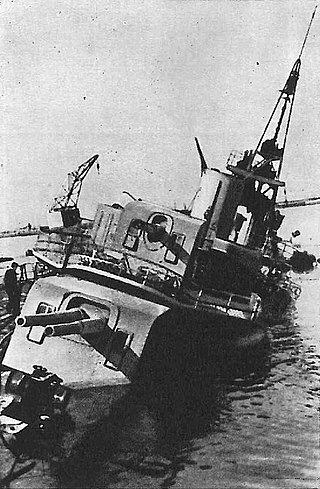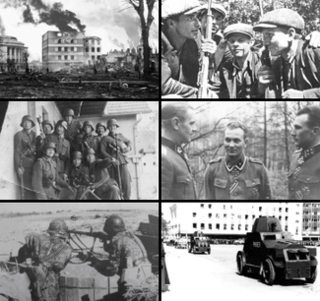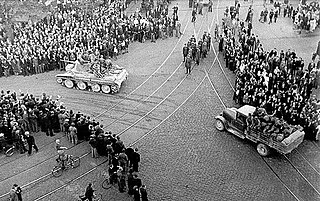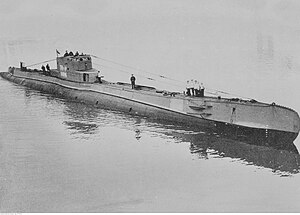
Harju County, is one of the fifteen counties of Estonia. It is situated in Northern Estonia, on the southern coast of the Gulf of Finland, and borders Lääne-Viru County to the east, Järva County to the southeast, Rapla County to the south, and Lääne County to the southwest. The capital and largest city of Estonia, Tallinn, is situated in Harju County. Harju County is the largest county in Estonia in terms of population, as almost half (45%) of the Estonia's population lives in Harju County.

ORP Orzeł was an Orzeł class submarine of the Polish Navy that served during WWII.

The Battle of Danzig Bay took place on 1 September 1939, at the beginning of the invasion of Poland, when Polish Navy warships were attacked by German Luftwaffe aircraft in Gdańsk Bay. It was the first naval-air battle of World War II.

The Baltic Sea campaigns were conducted by Axis and Allied naval forces in the Baltic Sea, the Gulf of Bothnia, the Gulf of Finland and the connected lakes Ladoga and Onega on the Eastern Front of World War II. After early fighting between Polish and German forces, the main combatants were the Kriegsmarine and the Soviet Navy, with Finland supporting the Germans until 1944 and the Soviets thereafter. The Swedish Navy and merchant fleet played important roles, and the British Royal Navy planned Operation Catherine for control of the Baltic Sea and its exit choke point into the North Sea.
ORP Wilk was the lead boat of her class of mine-laying submarines of the Polish Navy. The ship saw service in the Polish Navy from 1931 to 1951. Her name meant "Wolf" in Polish.
This article details the order of battle of the Polish Navy prior to the outbreak of World War II and the Polish Defensive War of 1939. Following World War I, Poland's shoreline was relatively short and included no major seaports. In the 1920s and 1930s, such ports were built in Gdynia and Hel, and the Polish Navy underwent a modernisation program under the leadership of Counter-Admiral Józef Unrug and Vice-Admiral Jerzy Świrski. Ships were acquired from France, the Netherlands, and the United Kingdom, and the navy was to be able to secure the Polish supply lines in case of a war against the Soviet Union. By September 1939 the Polish Navy consisted of 5 submarines, 4 destroyers, and various support vessels and mine-warfare ships.

The Peking Plan was an operation in which three destroyers of the Polish Navy, the Burza, Błyskawica, and Grom, were evacuated to the United Kingdom in late August and early September 1939. They were ordered to travel to British ports and assist the British Royal Navy in the event of a war with Nazi Germany. The plan was successful and allowed the ships to avoid certain destruction or capture in the German invasion.

The Worek Plan was an operation of the Polish Navy in the first days of World War II, in which its five submarines formed a screen in order to prevent German naval forces from carrying out landings on the Polish coast, and to attack enemy ships bombarding Polish coastal fortifications, in particular the base on the Hel Peninsula.

Kazimierz Leski, nom de guerreBradl, was a Polish engineer, co-designer of the Polish submarines ORP Sęp (1938) and ORP Orzeł, a fighter pilot, and an officer in World War II Home Army's intelligence and counter-intelligence.
The Orzeł class was a short series of submarines built in Dutch shipyards for the Polish Navy in the 1930s. Four submarines were planned but only two were completed. They saw service during World War II.

The history of Estonia from 1920 to 1939 spanned the interwar period from the end of the Estonian War of Independence until the outbreak of World War II. It covers the years of parliamentary democracy, the Great Depression and the period of corporatist authoritarian rule.

Estonia–Russia relations are the bilateral foreign relations between Estonia and Russia. Diplomatic relations between the two countries were established on 2 February 1920 after the Estonian War of Independence ended in Estonian victory with Russia recognizing Estonia's sovereignty and renounced any and all territorial claims on Estonia.

Estonia declared neutrality at the outbreak of World War II (1939–1945), but the country was repeatedly contested, invaded and occupied, first by the Stalinist Soviet Union in 1940, then by Nazi Germany in 1941, and ultimately reinvaded and reoccupied in 1944 by the Soviet Union.

This is a timeline of events of World War II in 1939, from the start of the war on 1 September 1939. For events preceding September 1, 1939, see the timeline of events preceding World War II.
The Eagle is a 1959 Polish war film directed by Leonard Buczkowski. It is based on the true story of the Polish World War II submarine ORP Orzeł. Since the real Orzeł was sunk in the war, to assure authenticity her role was played by her sister ship, the ORP Sęp. The film was entered into the 1st Moscow International Film Festival.
The timeline of the occupation of the Baltic states lists key events in the military occupation of the three countries – Estonia, Latvia and Lithuania – by the Soviet Union and by Nazi Germany during World War II.

The Soviet occupation of the Baltic states covers the period from the Soviet–Baltic mutual assistance pacts in 1939, to their invasion and annexation in 1940, to the mass deportations of 1941.

SS Rio de Janeiro was a German cargo steamship owned by the Hamburg Südamerikanische shipping company and registered in Hamburg. She was built as Santa Ines in 1914 and renamed Rio de Janeiro in 1921. Until World War II she carried passengers and freight between Germany and South America.

The Polish Navy is the naval branch of the Polish Armed Forces. The Polish Navy consists of 46 ships and about 12,000 commissioned and enlisted personnel. The traditional ship prefix in the Polish Navy is ORP.

Jan Grudziński was a submarine commander of the Polish Navy during World War II.

















